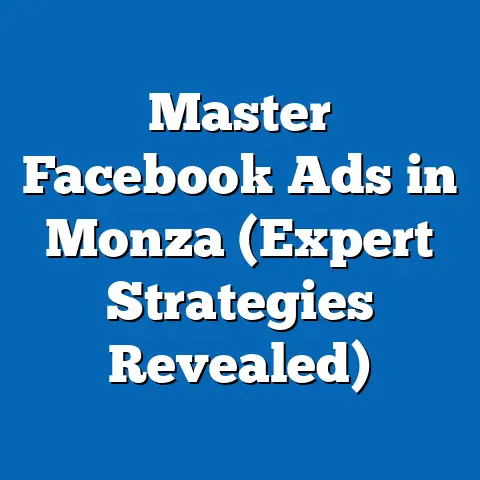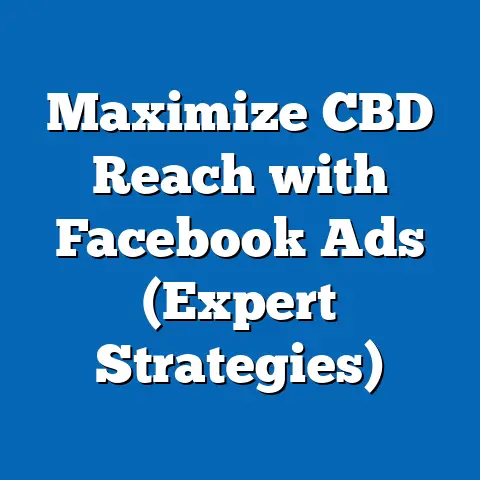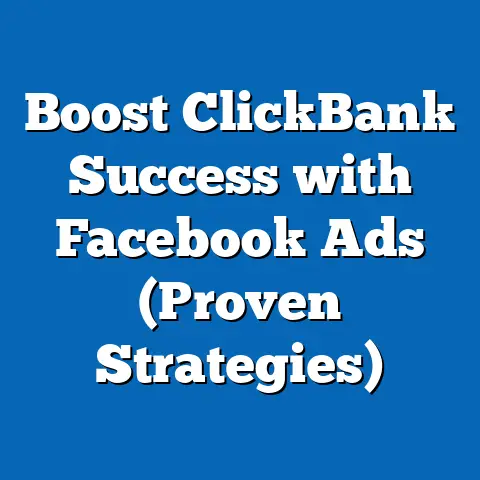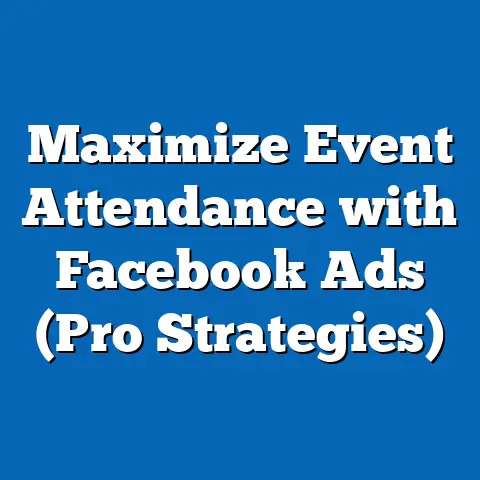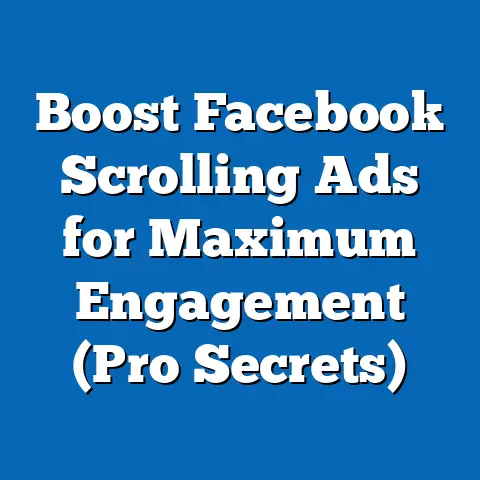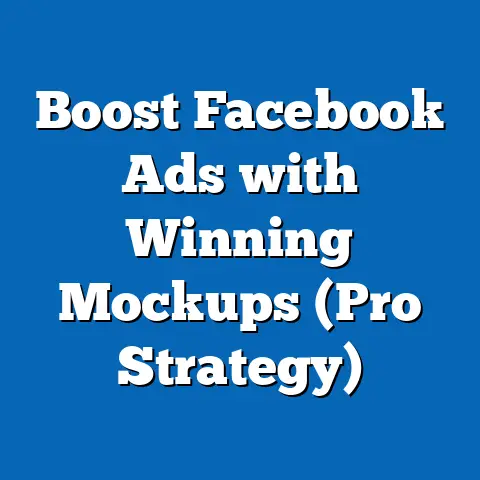Boost Engagement with Coursera Facebook Ads (Expert Tips)
In today’s digital age, investing in marketing is no longer an option, but a necessity. And when it comes to digital marketing, Facebook advertising stands out as a powerful tool. A well-structured investment in Facebook advertising can yield significant returns in terms of engagement, brand awareness, and ultimately, customer acquisition. Think of it as planting seeds in fertile ground – with the right care, those seeds will blossom into a thriving garden of engaged users.
Coursera, a prominent platform for online learning, is in a unique position to leverage the power of Facebook ads. By crafting strategic and engaging campaigns, Coursera can connect with potential learners, boost course sign-ups, and build a vibrant community around its educational offerings. Imagine the possibilities: reaching professionals seeking to upskill, students eager to explore new subjects, and lifelong learners hungry for knowledge – all through the targeted reach of Facebook.
This article is your guide to unlocking the full potential of Facebook advertising for Coursera. I’ll share expert tips and actionable strategies to maximize engagement, drive meaningful results, and help Coursera connect with its ideal audience. Get ready to transform your Facebook ad strategy and watch your engagement soar!
Understanding Facebook Ads
Facebook ads are more than just simple advertisements; they are a sophisticated system designed to connect businesses with their ideal customers. Understanding the nuances of this system is crucial for any marketer looking to achieve meaningful results.
Types of Facebook Ads
Facebook offers a diverse range of ad formats, each designed to achieve specific objectives and capture audience attention in unique ways. Here’s a breakdown of the most common types:
- Image Ads: These are the simplest form of Facebook advertising, featuring a single image with accompanying text. Image ads are great for showcasing products, announcing promotions, or conveying a simple message.
- Video Ads: Video ads are incredibly engaging and can be used to tell stories, demonstrate products, or share testimonials. They are particularly effective at capturing attention in the busy Facebook newsfeed.
- Carousel Ads: Carousel ads allow you to showcase multiple images or videos in a single ad unit. This format is ideal for highlighting different features of a product, showcasing a product line, or telling a multi-part story.
- Collection Ads: These ads are designed for e-commerce businesses and allow users to browse and purchase products directly from the ad. Collection ads typically feature a hero image or video along with a selection of related products.
- Lead Ads: Lead ads are designed to collect leads directly from Facebook users without requiring them to visit a website. This format is ideal for building email lists, offering free trials, or gathering information for sales outreach.
- Instant Experience Ads: Formerly known as Canvas ads, Instant Experience ads provide a full-screen, immersive experience within Facebook. These ads are highly engaging and can be used to tell compelling stories, showcase products in detail, or provide interactive content.
How Facebook’s Advertising Algorithm Works
Facebook’s advertising algorithm is the engine that powers the platform’s ad delivery system. It determines which ads are shown to which users based on a variety of factors, including:
- Bidding: Advertisers bid against each other to have their ads shown to a specific audience. The higher your bid, the more likely your ad is to be shown.
- Relevance Score: Facebook assigns a relevance score to each ad based on how well it resonates with the target audience. Ads with higher relevance scores are shown more often and at a lower cost.
- Estimated Action Rate: This is Facebook’s prediction of how likely a user is to take a desired action, such as clicking on an ad or making a purchase. Ads with higher estimated action rates are favored by the algorithm.
- Ad Quality: Facebook evaluates the quality of your ad creative based on factors such as image quality, text clarity, and overall user experience.
Understanding these factors is crucial for optimizing your Facebook ad campaigns and maximizing their effectiveness. By creating relevant, high-quality ads and bidding strategically, you can increase your chances of reaching your target audience and achieving your advertising goals.
My Experience: I remember when I first started running Facebook ads, I was completely overwhelmed by the algorithm. I spent countless hours trying to understand how it worked and how to optimize my campaigns accordingly. It was a steep learning curve, but I eventually realized that the key was to focus on creating high-quality, relevant ads that resonated with my target audience. Once I started doing that, my results improved dramatically.
Demographics and User Behavior on Facebook
Facebook boasts a massive and diverse user base, making it a valuable platform for reaching a wide range of audiences. However, understanding the demographics and user behavior on Facebook is crucial for effectively targeting your ads.
- Demographics: Facebook provides detailed demographic information about its users, including age, gender, location, education, and interests. This data allows you to target your ads to specific groups of people who are most likely to be interested in your products or services.
- Interests: Facebook tracks users’ interests based on their activity on the platform, including the pages they like, the groups they join, and the content they interact with. This allows you to target your ads to users who have expressed an interest in specific topics or industries.
- Behaviors: Facebook also tracks users’ behaviors, such as their purchase history, device usage, and travel habits. This data allows you to target your ads to users who are likely to take a specific action, such as making a purchase or signing up for a newsletter.
For Coursera, understanding the demographics and user behavior of individuals interested in online learning and professional development is paramount. This includes identifying age groups, educational backgrounds, career aspirations, and specific fields of interest. By leveraging Facebook’s targeting capabilities, Coursera can ensure that its ads reach potential students who are most likely to be interested in its courses and programs.
Takeaway: Facebook ads offer a powerful way to reach a vast audience, but success hinges on understanding the platform’s algorithm, ad formats, and user demographics. By mastering these fundamental elements, you can create targeted campaigns that drive engagement and achieve your marketing goals.
Setting Goals for Engagement
Before diving headfirst into creating Facebook ads for Coursera, it’s essential to define what “engagement” actually means to you and, more importantly, how you’ll measure it. Think of it like setting a destination on a GPS – you can’t get there if you don’t know where you’re going!
The Importance of Clear, Measurable Goals
Setting clear, measurable goals provides a roadmap for your Facebook ad campaigns. Without them, you’re essentially throwing money at the wall and hoping something sticks. Here’s why goal setting is so critical:
- Focus: Goals provide a clear direction for your efforts, ensuring that your ad campaigns are aligned with your overall marketing objectives.
- Measurement: Measurable goals allow you to track your progress and determine whether your campaigns are successful.
- Optimization: By analyzing your results against your goals, you can identify areas for improvement and optimize your campaigns for better performance.
- Accountability: Goals provide a sense of accountability, motivating you to stay focused and committed to achieving your desired outcomes.
Leveraging Engagement Metrics
Facebook provides a wealth of data to help you assess the performance of your ad campaigns. Here are some key engagement metrics to track:
- Likes: The number of users who have liked your ad or post.
- Comments: The number of users who have commented on your ad or post.
- Shares: The number of users who have shared your ad or post with their friends.
- Click-Through Rate (CTR): The percentage of users who saw your ad and clicked on it.
- Engagement Rate: The percentage of users who saw your ad and interacted with it in some way (e.g., liking, commenting, sharing, clicking).
- Cost Per Engagement (CPE): The average cost of each engagement on your ad.
- Video Views: The number of users who have watched your video ad.
- Website Traffic: The amount of traffic driven to your website from your Facebook ads.
- Conversions: The number of users who have taken a desired action on your website after clicking on your Facebook ad (e.g., signing up for a course, making a purchase).
Specific Engagement Goals for Coursera
For Coursera, specific engagement goals might include:
- Increasing course sign-ups: This is a primary goal for many Coursera campaigns. Track the number of users who sign up for courses after clicking on your Facebook ads.
- Driving traffic to specific courses: If you’re promoting a particular course, track the amount of traffic driven to the course page from your Facebook ads.
- Generating leads for email lists: Build your email list by offering a free resource or discount in exchange for users’ email addresses. Track the number of leads generated from your Facebook ads.
- Boosting brand awareness: Increase brand awareness by reaching a wider audience and generating positive engagement with your ads. Track metrics such as reach, impressions, and engagement rate.
- Promoting new course launches: Use Facebook ads to announce new course launches and drive early sign-ups. Track the number of sign-ups generated within the first few days of the launch.
- Increasing engagement with existing courses: Encourage users to complete courses they’ve already started by sending them targeted ads with reminders and motivational messages.
Example: Let’s say Coursera wants to increase sign-ups for its “Data Science Specialization” course. A specific engagement goal could be: “Increase sign-ups for the Data Science Specialization by 20% within the next month through Facebook ads.”
To achieve this goal, Coursera would need to:
- Track the current number of sign-ups for the Data Science Specialization.
- Create Facebook ads that promote the course and highlight its benefits.
- Target the ads to users who are interested in data science and related topics.
- Monitor the performance of the ads and make adjustments as needed.
- Measure the number of sign-ups generated from the ads and compare it to the baseline.
Takeaway: Setting clear, measurable engagement goals is essential for the success of your Facebook ad campaigns. By defining what you want to achieve and tracking your progress, you can optimize your campaigns for better performance and maximize your return on investment.
Crafting Compelling Ad Content
Creating compelling ad content is the heart of any successful Facebook advertising campaign. It’s the art of capturing attention, sparking interest, and ultimately driving engagement. Think of your ad as a tiny storefront in a bustling marketplace – you need to make it stand out to attract customers!
The Power of Storytelling and Emotional Appeal
People are naturally drawn to stories. By incorporating storytelling and emotional appeal into your ad content, you can create a stronger connection with your audience and increase engagement.
- Tell a story: Share a success story from a Coursera student who transformed their career after completing a course.
- Highlight the benefits: Focus on the tangible benefits of taking a Coursera course, such as increased earning potential, career advancement, or personal growth.
- Tap into emotions: Appeal to your audience’s emotions by highlighting the joy of learning, the satisfaction of achieving goals, or the excitement of discovering new knowledge.
Example: Instead of simply saying “Take our Data Science course,” try telling a story about a student who used the skills they learned in the course to land their dream job.
The Role of Visuals and Video
Visuals and video are incredibly powerful tools for capturing attention and enhancing engagement on Facebook.
- Use high-quality images: Choose images that are visually appealing, relevant to your ad content, and optimized for Facebook’s ad specifications.
- Create engaging videos: Videos are particularly effective at capturing attention in the busy Facebook newsfeed. Keep your videos short, engaging, and visually appealing.
- Use visuals to tell a story: Use visuals to illustrate your story and make your ad content more compelling.
My Experience: I’ve found that video ads consistently outperform image ads in terms of engagement. People are more likely to watch a short video than to read a block of text. However, it’s important to create videos that are high-quality, relevant, and engaging. A poorly produced video can actually damage your brand.
Writing Effective Ad Copy
Your ad copy is just as important as your visuals. It’s your opportunity to explain the value of your offer and persuade users to take action.
- Keep it concise: People have short attention spans, so keep your ad copy short and to the point.
- Highlight the benefits: Focus on the benefits of taking a Coursera course, not just the features.
- Use a strong call to action: Tell users exactly what you want them to do, such as “Sign Up Now” or “Learn More.”
- Use persuasive language: Use words that evoke emotion and create a sense of urgency.
- Align with Coursera’s brand voice: Ensure that your ad copy is consistent with Coursera’s overall brand voice and messaging.
Example:
- Bad: “Take our Python course.”
- Good: “Learn Python and unlock a world of career opportunities. Sign up now and get 20% off!”
Aligning Ad Content with Coursera’s Brand
It’s crucial to ensure that your Facebook ad content aligns with Coursera’s brand voice and educational mission. This means:
- Maintaining a professional tone: Coursera is a respected educational institution, so your ad content should reflect that.
- Focusing on education and learning: Emphasize the educational value of Coursera’s courses and programs.
- Highlighting Coursera’s mission: Connect your ad content to Coursera’s mission of providing access to high-quality education for everyone.
Takeaway: Crafting compelling ad content is essential for driving engagement on Facebook. By incorporating storytelling, using high-quality visuals, writing effective ad copy, and aligning with Coursera’s brand, you can create ads that capture attention, spark interest, and persuade users to take action.
Targeting the Right Audience
Imagine casting a wide net into the ocean hoping to catch a specific type of fish. You might catch something, but you’ll likely waste a lot of time and energy. That’s what running Facebook ads without proper targeting is like. Targeting the right audience is crucial for ensuring that your ads reach potential Coursera users effectively and maximizing your return on investment.
Facebook’s Targeting Options
Facebook offers a wide range of targeting options, allowing you to reach specific groups of people based on their demographics, interests, and behaviors.
- Demographics: Target users based on age, gender, location, education, relationship status, and more.
- Interests: Target users based on their interests, such as specific hobbies, activities, or topics.
- Behaviors: Target users based on their behaviors, such as their purchase history, device usage, and travel habits.
- Custom Audiences: Create custom audiences based on your own data, such as website visitors, email lists, or app users.
- Lookalike Audiences: Create lookalike audiences based on your existing customers or engaged users.
Creating Custom Audiences
Custom audiences allow you to target your ads to people who have already interacted with your business in some way. This can be a highly effective way to drive engagement and conversions.
- Website Visitors: Target users who have visited specific pages on your website. For example, you could target users who have visited the page for a particular Coursera course.
- Email Lists: Upload your email list to Facebook and target users who are on your list. This is a great way to reach your existing customers and subscribers.
- App Users: Target users who have downloaded your mobile app.
- Engagement: Target users who have engaged with your Facebook page or ads in the past.
Leveraging Lookalike Audiences
Lookalike audiences allow you to reach new potential students who resemble your existing engaged users. This is a powerful way to expand your reach and find new customers.
- Seed Audience: Choose a seed audience, such as your existing customers or engaged users.
- Facebook’s Algorithm: Facebook’s algorithm will analyze the characteristics of your seed audience and find new users who share similar traits.
- Expand Your Reach: Lookalike audiences can help you expand your reach and find new potential students who are likely to be interested in Coursera’s courses and programs.
My Experience: I’ve had great success using lookalike audiences. I typically start by creating a lookalike audience based on my existing customers and then gradually expand the audience size to reach a wider range of potential customers.
A/B Testing Audience Segments
A/B testing different audience segments is crucial for optimizing ad performance. By testing different audiences, you can identify which segments are most responsive to your ads and focus your efforts on those segments.
- Create Multiple Audiences: Create multiple audience segments based on different demographics, interests, and behaviors.
- Run A/B Tests: Run A/B tests to compare the performance of different audience segments.
- Analyze Results: Analyze the results of your A/B tests and identify which audience segments are performing best.
- Optimize Campaigns: Optimize your campaigns by focusing on the audience segments that are most responsive to your ads.
Takeaway: Targeting the right audience is essential for the success of your Facebook ad campaigns. By leveraging Facebook’s targeting options, creating custom audiences, utilizing lookalike audiences, and A/B testing different audience segments, you can ensure that your ads reach potential Coursera users effectively and maximize your return on investment.
Budgeting and Bidding Strategies
Even the most creative and well-targeted Facebook ad campaigns can fall flat if not supported by a smart budgeting and bidding strategy. Think of it like fueling a race car – you need the right amount of fuel to reach the finish line!
Budgeting Options: Daily vs. Lifetime
Facebook offers two main budgeting options: daily budgets and lifetime budgets.
- Daily Budget: A daily budget allows you to set a fixed amount of money that you’re willing to spend on your ads each day. This is a good option if you want to ensure that your ads are running consistently throughout the day.
- Lifetime Budget: A lifetime budget allows you to set a total amount of money that you’re willing to spend on your ads over a specific period of time. This is a good option if you want to control your overall ad spend and ensure that you don’t exceed your budget.
My Recommendation: For most Coursera campaigns, I recommend starting with a daily budget. This allows you to monitor your ad performance closely and make adjustments as needed. Once you have a better understanding of your ad performance, you can switch to a lifetime budget if you prefer.
Choosing the Best Bidding Strategy
Facebook offers a variety of bidding strategies, each designed to achieve different objectives.
- Lowest Cost: This bidding strategy aims to get you the most results for your budget. Facebook will automatically bid on your behalf to get you the lowest possible cost per result.
- Cost Cap: This bidding strategy allows you to set a target cost per result. Facebook will try to get you results at or below your target cost.
- Target Cost: Similar to Cost Cap, this bidding strategy focuses on maintaining a specific cost per result, but it may be less flexible with delivery.
- Bid Cap: This bidding strategy allows you to set a maximum bid for each auction. Facebook will never bid more than your maximum bid.
- Manual Bidding: This bidding strategy allows you to manually set your bids for each auction. This gives you the most control over your bidding, but it also requires more expertise.
My Recommendation: For most Coursera campaigns focused on engagement, I recommend starting with the “Lowest Cost” bidding strategy. This allows Facebook to optimize your bids for the most engagement at the lowest possible cost. As you gain more experience, you can experiment with other bidding strategies to see if you can improve your results.
Monitoring Ad Spend and Maximizing ROI
It’s crucial to monitor your ad spend and make adjustments as needed to maximize your ROI.
- Track Your Metrics: Track key metrics such as cost per click (CPC), cost per engagement (CPE), and conversion rate.
- Analyze Your Results: Analyze your results and identify areas for improvement.
- Adjust Your Bids: Adjust your bids based on your results. If your CPC or CPE is too high, try lowering your bids. If your conversion rate is low, try improving your ad creative or targeting.
- Pause Underperforming Ads: Pause any ads that are not performing well.
- Optimize Your Campaigns: Continuously optimize your campaigns to improve your ROI.
Example: Let’s say Coursera is running a Facebook ad campaign to promote its “Machine Learning Specialization.” After a week, they notice that the CPC is higher than expected. To address this, they could try:
- Lowering their bids: This will reduce their chances of winning auctions, but it will also lower their CPC.
- Improving their ad creative: This will make their ads more appealing to users and increase their click-through rate.
- Refining their targeting: This will ensure that their ads are being shown to the most relevant audience.
Takeaway: Budgeting and bidding strategies are essential for the success of your Facebook ad campaigns. By choosing the right budgeting option, selecting the best bidding strategy, monitoring your ad spend, and maximizing your ROI, you can ensure that your investment in Facebook ads is yielding the desired results.
Analyzing and Optimizing Performance
You’ve launched your Coursera Facebook ad campaigns, and the data is rolling in. But what do you do with it? Analyzing and optimizing performance is the crucial step that transforms raw data into actionable insights, allowing you to fine-tune your campaigns for maximum engagement and ROI. Think of it like a chef tasting their dish and adding spices to perfect the flavor!
The Importance of Analytics
Analytics are the backbone of any successful Facebook ad campaign. They provide the data you need to understand how your ads are performing and identify areas for improvement.
- Track Key Metrics: Monitor key metrics such as reach, impressions, engagement rate, click-through rate (CTR), cost per engagement (CPE), and conversion rate.
- Identify Trends: Look for trends in your data to identify what’s working and what’s not.
- Make Data-Driven Decisions: Use your data to make informed decisions about how to optimize your campaigns.
Facebook Ads Manager: Your Analytics Hub
Facebook Ads Manager is your central hub for analyzing the performance of your Facebook ad campaigns. It provides a wealth of data and tools to help you understand how your ads are performing.
- Overview: The Ads Manager overview provides a summary of your campaign performance, including key metrics such as reach, impressions, and cost.
- Reporting: The Ads Manager reporting tool allows you to create custom reports to track specific metrics over time.
- Attribution: The Ads Manager attribution tool helps you understand which ads are driving the most conversions.
Key Metrics to Track
Here’s a deeper dive into some of the key metrics you should be tracking for your Coursera Facebook ad campaigns:
- Reach: The number of unique people who saw your ads.
- Impressions: The number of times your ads were shown.
- Engagement Rate: The percentage of people who saw your ads and interacted with them in some way (e.g., liking, commenting, sharing, clicking).
- Click-Through Rate (CTR): The percentage of people who saw your ads and clicked on them. A high CTR indicates that your ads are relevant and appealing to your target audience.
- Cost Per Engagement (CPE): The average cost of each engagement on your ad. A low CPE indicates that you’re getting a good return on your investment.
- Conversion Rate: The percentage of people who clicked on your ads and took a desired action, such as signing up for a course or making a purchase. A high conversion rate indicates that your landing page is effective and that you’re targeting the right audience.
- Return on Ad Spend (ROAS): This metric measures the revenue generated for every dollar spent on advertising. It’s a critical indicator of campaign profitability.
Interpreting Data and Optimizing Campaigns
Interpreting the data you collect is crucial for making informed decisions about how to optimize your campaigns.
- Identify Underperforming Ads: Identify ads that are not performing well and pause them.
- Improve Ad Creative: Experiment with different ad creative to see what resonates best with your audience. Try different images, videos, and ad copy.
- Refine Targeting: Refine your targeting to ensure that your ads are being shown to the most relevant audience.
- Adjust Bids: Adjust your bids based on your results. If your CPC or CPE is too high, try lowering your bids. If your conversion rate is low, try improving your ad creative or targeting.
- A/B Testing: Continuously A/B test different elements of your campaigns to see what works best.
My Experience: I’ve found that A/B testing is one of the most effective ways to optimize my Facebook ad campaigns. I typically test different ad creative, targeting options, and bidding strategies to see what yields the best results.
Example: Let’s say Coursera is running a Facebook ad campaign to promote its “Web Development Bootcamp.” After a week, they notice that the CTR is low. To address this, they could try:
- Improving their ad creative: They could try using different images or videos, or they could try writing different ad copy.
- Refining their targeting: They could try targeting a different audience segment or adding more interests to their targeting.
The Importance of Feedback Loops
Creating feedback loops is essential for continuous improvement.
- Gather Feedback: Gather feedback from your audience about your ads. Ask them what they like and dislike about your ads.
- Analyze Feedback: Analyze the feedback you receive and use it to improve your ads.
- Iterate: Continuously iterate on your ads based on the feedback you receive.
Takeaway: Analyzing and optimizing performance is essential for maximizing the effectiveness of your Facebook ad campaigns. By tracking key metrics, interpreting data, and creating feedback loops, you can fine-tune your campaigns for maximum engagement and ROI.
Conclusion
We’ve journeyed through the world of Facebook advertising for Coursera, exploring everything from understanding the platform and setting goals to crafting compelling content and optimizing performance. I hope this guide has provided you with valuable insights and actionable strategies to boost engagement and drive meaningful results.
Remember, investing in Facebook ads is an investment in your brand’s growth and reach. By strategically targeting your audience and crafting engaging content, you can connect with potential learners, boost course sign-ups, and build a vibrant community around Coursera’s educational offerings.
The potential impact of well-targeted, engaging ads on user acquisition and course enrollment is immense. Imagine the possibilities: reaching professionals seeking to upskill, students eager to explore new subjects, and lifelong learners hungry for knowledge – all through the targeted reach of Facebook.
I encourage you to apply the expert tips and strategies shared in this article to enhance your own Facebook ad campaigns for Coursera. By continuously testing, analyzing, and optimizing your campaigns, you can drive meaningful engagement, achieve your marketing goals, and contribute to Coursera’s mission of providing access to high-quality education for everyone.
So, go forth and create impactful Facebook ad campaigns that resonate with your audience, spark their curiosity, and inspire them to embark on a journey of lifelong learning with Coursera! The world of online education awaits, and Facebook ads can be the key to unlocking its full potential.

